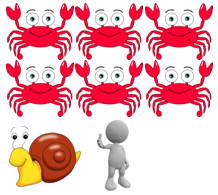This is an activity based on the picture book One is a snail, ten is a crab: A counting feet book
- Students will be able to partition a number between 10-100.
- Students will be able to express a number between 10-100 as combinations and/or multiples of other numbers using a model and a mathematical equation.
Numbers can be expressed as the sum of other numbers.
Numbers can be partitioned in different ways.
- Large hundreds board
- Grab bag with numbers 10-100 (can be made by cutting up Material Master 4-4)
- One is a snail, ten is a crab: A counting feet book by April Pulley Sayre and Jeff Sayre
- Copymaster (optional)
Footprints on the hundreds board
This activity is based on the picture book: One is a snail, ten is a crab: A counting feet book
Author: April Pulley Sayre and Jeff Sayre
Illustrator: Randy Cecil
Publisher: Walker (2004)
ISBN: 1-844-28164-7
Summary:
When you are counting by feet then 1 is a snail and 2 is a person and 4 is a dog! This book uses the number of feet on various animals to be the units by which numbers can be expressed. So for example: “40” can be 10 dogs (10 x 4) or 20 people (20 x 2) or 6 insects and a dog (6 x 6 + 4). The book is a humorous and colourful illustration of part-whole thinking.
Lesson Sequence:
Prior to this lesson you can have created copymasters of your own children’s drawings of the “units” (snail, person, dog, insect, crab) by asking someone to draw one of each and then reproducing them on a photocopier to create sheets of units or you can use the copymaster of clip art “units” or you can have each child do their own drawings for the activity.
- Prior to reading, warm up with some number recognition and partitioning questions. “Play Guess my Number” with the hundreds board by choosing a “mystery number” in your mind and having students ask questions to narrow the search for the mystery number (Does it have a 2 in the ones column? etc.). Reverse the game and give clues that help them narrow the search for another number (for example: My number has an even number in the tens column, or My number is 4 more than tidy number, or My number is made up of a two digits that are the same, etc.)
- Share the book with your students stopping to record the mathematics on each page. For example: 6 is 3 people, or a dog and a person, or 1 insect.
How would we write those? 3 people is 3 x 2, 1 dog and 1 person is 4 + 2, 1 insect is 1 x 6
Is there any other way we could make 6? - After reading the book explain to students that they (or their pair) will each get to pull a number from the bag and make that number in 2 ways using the counting feet from the story.
Model one example for them by taking a piece of A4 or A3 paper and folding in quarters. Unfold and record the following labels 1 per quarter:
MY NUMBER; WORDS; PICTURE; EQUATION
Turn the paper over and label the same on the other side.
Select a number from the grab bag and with their support fill in each quarter. For example:My Number
63
Words
six crabs
one person
one snailPicture
Equation
63 = 6 x 10 + 2 + 1Then ask
What is another way I could make 63?
Show them how you would do that other way on the reverse side of the paper.- Students then draw numbers from the bag and use the materials provided to make a two-page “Number Footprint”. Circle the numbers that have been drawn out on the hundreds board as students may want to make more pages later as an independent activity and then can select numbers not already illustrated.
- Compile all the pages together to publish a class book.
- As an extension or follow up activity you can investigate other units such as octopus, centipede, or starfish and explore the multiples of each unit by itself before combining with others.
